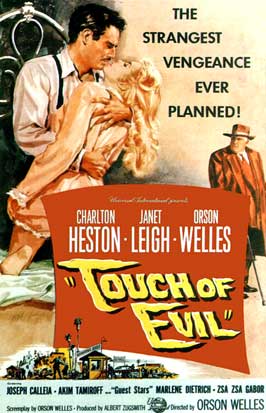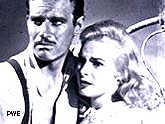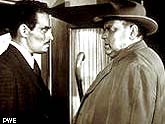FILM NOTES
FILM NOTES INDEX
NYS WRITERS INSTITUTE
HOME PAGE

 Touch of Evil
Touch of Evil
(American, 1958, 112 minutes, b&w, 35mm)
Directed by Orson Welles
Cast:
Orson Welles . . . . . . . . . . Hank Quinlan
Charlton Heston . . . . . . . . . . Ramon Miguel ‘Mike’ Vargas
Janet Leigh . . . . . . . . . . Susan Vargas
Joseph Calleia . . . . . . . . . . Pete Menzies
Marlene Dietrich . . . . . . . . . . Tanya
The
following film notes were prepared for the New York State Writers
Institute by Kevin Jack Hagopian, Senior Lecturer in Media Studies
at Pennsylvania State University:
It is one of the most bravura moments in film history. On an oil-black night in an unkempt border town, a hand is seen winding a clock mechanism, and then stuffing a bomb into a car trunk. Then, the bomber withdraws, a couple arrives, the car drives off, and the camera begins pulling back, up and around seedy buildings, down fly-blown streets, past odd revelers flowing through a customs gate. And then a blonde floozy chirping, "Hey! What’s that ticking?!!! I can’t get that ticking out of my head!"
This camera crane arabesque is the opening of Orson Welles’ TOUCH OF EVIL, perhaps the last great masterpiece of the film noir era. Along with John Huston’s equally remarkable THE MALTESE FALCON of 1941, TOUCH OF EVIL neatly bookends film noir. Stylistically, the films are worlds apart. Huston’s film is crisp and clear and witty, while Welles’ is murky and full of hate. The mechanics of filmmaking in TOUCH OF EVIL, the play of shot and countershot, of dialogue and ambient sound, seem glutted by some strange weariness, the film’s motives and events and meanings clouded by ambiguity. Perhaps noir could simply go no further than the appallingly corrupt vision of society TOUCH OF EVIL provides. Perhaps noir ground to a halt because of TOUCH OF EVIL, its gears hopelessly fouled by the rust of greed, the corrosion of failed hopes. And perhaps even noir could imagine no more genuinely tragic a hero than the vast ruin of humanity that is Hank Quinlan, TOUCH OF EVIL’s sweat-stained version of a mad genius. . .
TOUCH OF EVIL began as a workaday thriller based on a pulpy crime novel called Badge of Evil. The script was submitted to Charlton Heston in the months before THE TEN COMMANDMENTS made him huge. The film’s studio, Universal, became prosperous in end-of-an-era Hollywood by building action films around male ingenues like Tony Curtis, Jeff Chandler, and Rock Hudson. TOUCH OF EVIL, recognized Heston, was to be more of the same. He was intrigued, though, by the presence of Orson Welles in a draft of the film’s cast list. Beginning with BLACK MAGIC, in which he played Cagliostro, THE PRINCE OF FOXES, in which he played Cesare Borgia, and THE THIRD MAN, in which he played the unforgettably sinister Harry Lime, all made in 1949, Welles financed his increasingly quixotic directing ventures with brilliant, overblown character turns in other peoples’ movies, often a Gulliver among the Lilliputians. Playing larger-than-life figures out of history (Clarence Darrow in 1959’s COMPULSION) or fiction (1958’s THE LONG HOT SUMMER, from William Faulkner), Welles tacked between the US and Europe, sinking his increasing earnings as an actor into decreasingly profitable films like OTHELLO, MR. ARKADIN, and the suitably unfinished DON QUIXOTE. Initially, TOUCH OF EVIL was to be no more than the latest source of cash for Welles’ latest directing project.
 Heston says it was he who suggested that Welles direct TOUCH OF EVIL, and it appears that the studio got Welles at a bargain, "allowing" him to direct for his acting fee. In any case, Welles began by completely rewriting the script in two weeks, making the whodunit angle subordinate to the tale of urban and personal decay that remains the film’s most compelling constellation of ideas. Welles also conned cronies like Joseph Cotten and Ray Collins of CITIZEN KANE, Marlene Dietrich, Dennis Weaver, Akim Tamiroff, Zsa Zsa Gabor, and Harry Shannon (who’d played young Charlie Kane’s father in CITIZEN KANE) into playing small roles in the film. Slyly, Welles included Mercedes McCambridge among the motorcycle gang that terrorizes Janet Leigh.
Heston says it was he who suggested that Welles direct TOUCH OF EVIL, and it appears that the studio got Welles at a bargain, "allowing" him to direct for his acting fee. In any case, Welles began by completely rewriting the script in two weeks, making the whodunit angle subordinate to the tale of urban and personal decay that remains the film’s most compelling constellation of ideas. Welles also conned cronies like Joseph Cotten and Ray Collins of CITIZEN KANE, Marlene Dietrich, Dennis Weaver, Akim Tamiroff, Zsa Zsa Gabor, and Harry Shannon (who’d played young Charlie Kane’s father in CITIZEN KANE) into playing small roles in the film. Slyly, Welles included Mercedes McCambridge among the motorcycle gang that terrorizes Janet Leigh.
What began as a routine assignment for some forgotten contract director was transformed the moment Orson Welles laid hands on it. Its very cheapness, and Welles’ ability to make poetry out of poverty, instantly endeared the film to prescient critics. Francois Truffaut, then on the verge of his own career as a director, reviewed the film for a small magazine in France. He stood in awe of Welles and TOUCH OF EVIL, one of those rare "films that call the cinema to order . . . A capricious genius, Welles preaches to his parishioners and seems to be clearly telling us: ‘I’m sorry I’m so slovenly; it’s not my fault if I’m a genius; I’m dying: love me . . .’ May we always have enough taste, sensitivity, and intuition to admit that this talent is large and beautiful."
Universal apparently got a sadistic pleasure out of taunting Welles with his reputation as a spendthrift. As he had on 1946’s THE STRANGER, also produced for a cost-conscious studio, Welles kept scrupulously to budget. On TOUCH OF EVIL, the long takes he had come to favor as a storytelling technique now became a way of saving shooting time and money. Welles decided to put obnoxious Universal executives off with a remarkable display. He scheduled the now-celebrated "shoe box" scene for the first day of shooting. Welles shot thirteen pages of script, most of it in a single shot as complicated as the film’s opening. The material had been planned to take three days, and the Universal suits, satisfied, left Welles in peace thereafter.
 Welles’ devotion to the long take with camera movement meant that shots often became like theatrical performances, with a huge number of actors and technicians having to be coordinated to achieve a single result. Heston remembers trying to get in a few more takes of the film’s famous first shot before daylight. Several successive takes were ruined by the bit actor playing the customs man, who became terrified on seeing the huge entourage of booms, lights, cameras, actors, and vehicles bearing down on him determinedly from across town. He kept forgetting his single line, ruining the entire take. Heston remembered Welles chewing the man out after the third or forth time the shot had been wrecked: "Look, I don’t care what you say, just move your lips, we can dub it in later. Don’t just put your face in your hands and say, ‘Oh, my God, I’m sorry.’" In the end, the dialogue was dubbed.
Welles’ devotion to the long take with camera movement meant that shots often became like theatrical performances, with a huge number of actors and technicians having to be coordinated to achieve a single result. Heston remembers trying to get in a few more takes of the film’s famous first shot before daylight. Several successive takes were ruined by the bit actor playing the customs man, who became terrified on seeing the huge entourage of booms, lights, cameras, actors, and vehicles bearing down on him determinedly from across town. He kept forgetting his single line, ruining the entire take. Heston remembered Welles chewing the man out after the third or forth time the shot had been wrecked: "Look, I don’t care what you say, just move your lips, we can dub it in later. Don’t just put your face in your hands and say, ‘Oh, my God, I’m sorry.’" In the end, the dialogue was dubbed.
It was Welles who made Venice, California double for Los Robles, a Mexican border town. "Remind me," said an interviewer, "not to visit Venice, California." Perhaps Welles, essentially by 1958 a man without a country, had a special feeling for places like Los Robles and their local warlords. THE MALTESE FALCON’s portly "Caspar Gutman" (Sidney Greenstreet) was a faintly jesting presence in a film that finally enjoyed its own machinations; Hank Quinlan, TOUCH OF EVIL’s fat man, on the other hand, begins as a bloody-handed tyrant and ends as a lapsed romantic. (Truffaut wondered, "Who’s to say that one day he will not make us weep over the fate of Hermann Goering?") Surrounded as he is by weirdos like the Grandi crime family and the Shakespearean "night man" at the Grandi’s motel, Hank Quinlan seems a relatively heroic figure in a town where pathologies substitute for street addresses. Truffaut again: in Hank Quinlan, Welles "designed the simplest of moralities: that of the absolute and the purity of absolutists."
From the first moments of the film, TOUCH OF EVIL exults in a richly-detailed mise-en-scene. Few films have such a profoundly allegorical sense of place. TOUCH OF EVIL is fetid and stifling. We can smell garbage and waste oil blowing in on the hot Mexican wind. With its rundown hotel rooms and stinking barrooms, Los Robles is the grimy summa of all the cracked and faded towns in the whole history of film noir. The first great film noir, THE MALTESE FALCON, had ended with the restoration of a moral center, and a fundamentally hopeful epitaph: "This is the stuff that dreams are made of." Far more grimly, TOUCH OF EVIL ends at the water’s edge, in despair for a lost sense of order. Here, in the shadow of a clanking oil derrick, in a trash-filled lagoon, is where dreams go to die.
— Kevin Hagopian, Penn State University
For additional information, contact the Writers Institute at 518-442-5620 or online at https://www.albany.edu/writers-inst.